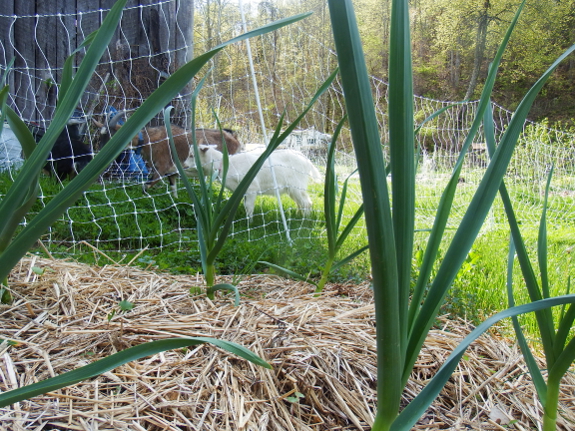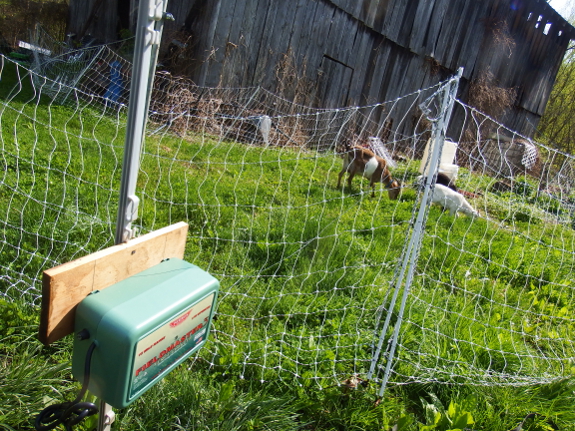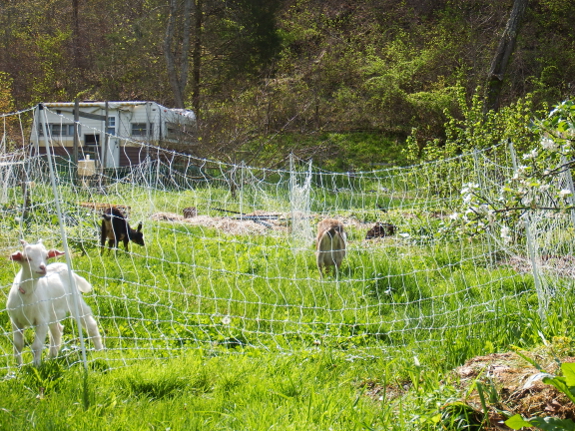
Setting up the goat electric fence

We finally hooked up the temporary electric fencing
as a way of leaving the goats alone in the garden unattended. Okay, so I
sat with the herd for an hour first while Lamb Chop learned that the
fence bites (this took four tries and he finally ended up lying in the
middle of the temporary pasture with a very glum look on his
face). And even after that, I checked in every five minutes just in
case. But both Artemesia and Abigail came from electric-fence-friendly
households and gave the netting a wide berth. No need to re-up any
training there.

When Daddy "lent" us this
electric fence system, he included a solar charger. I'm no sure if the
battery had died in his charger while it had been sitting in his shed
for a few years or what, but we had no luck getting the solar charger to
work. A new plug-in charger
won't let us fence the goats as far afield, but it worked like a charm
(even though Mark had to test the wire with his fingers since our fence tester apparently doesn't work either).
Figuring out grounding rods was the other part of the endeavor that left
us scratching our heads for a while. The instructions suggested
pounding in three grounding rods six feet deep and ten feet apart. We
instead settled for one grounding rod pushed about 18 inches into the
ground so it will be easy to move to the next location, which seems to
be quite sufficient in our wet ground.

The electric fence will definitely have a niche in our goat-grazing campaign, but I have to admit that I find tethering
simpler to set up and easier to manage. Sure, Lamb Chop can't nurse
while he's tethered, and it would be tougher to tether goats in areas
with high weeds or brush, but for grazing little corners of our core
homestead, the tethers seem to be the way to go. After all, I don't
trust our girls alone in the garden even with an electric shock standing
between them and my cabbages, so I might as well just let them graze
while I weed and keep my blood pressure low.
Want more in-depth information? Browse through our books.
Or explore more posts by date or by subject.
About us: Anna Hess and Mark Hamilton spent over a decade living self-sufficiently in the mountains of Virginia before moving north to start over from scratch in the foothills of Ohio. They've experimented with permaculture, no-till gardening, trailersteading, home-based microbusinesses and much more, writing about their adventures in both blogs and books.
Want to be notified when new comments are posted on this page? Click on the RSS button after you add a comment to subscribe to the comment feed, or simply check the box beside "email replies to me" while writing your comment.

Hi Anna and Mark and all,
Sometimes it can be helpful to connect the wires on a multiple wire portable electric fence alternately to the high voltage wire and to ground with the top wire the charged one.
That is carry two wires voltage and ground from the charger to the fence.
This is particularly helpful if the ground is not highly conductive or the animals have learned how to 'cheat' the fence.
Nita --- You're totally right. And I suspect we'll get to a stage where we have real pastures to fence the right way some day! In the meantime, I'm just feeding the goats grassy weeds in all the little corners of our core homestead amid trees, berries, and vegetable garden, which is why I like the tethers --- I can put Abigail in a tiny space, let her eat it all the way down, then move her in an hour to "mow" the next bit of lawn. My "pastures" so far are far too spotty to be worth using the electric fence on.
John --- Thanks for the tips!